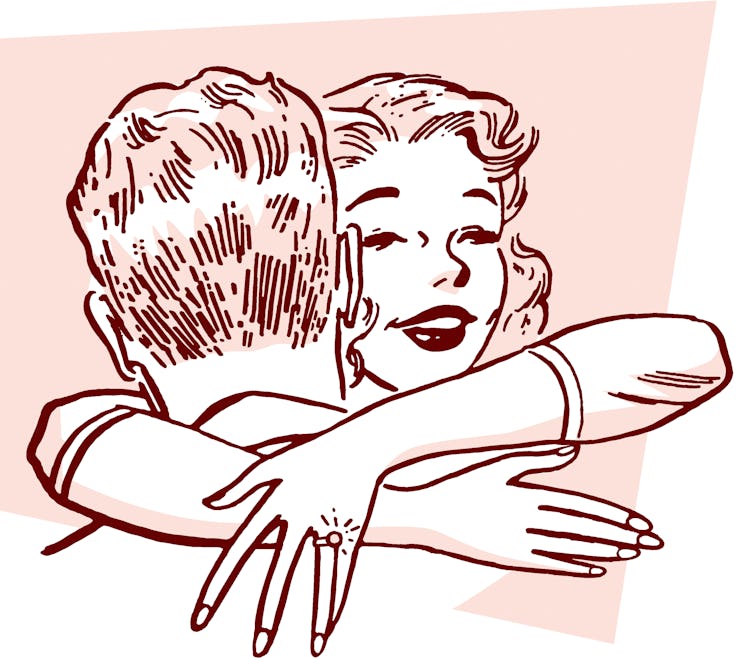A pandemic-friendly guide to hugging during Covid-19: 6 tips
A simple hug could have serious consequences.

In the time of Covid, greetings are no longer by handshakes, hugs, or kisses on the cheek. An “elbow bump” is the preferred pandemic greeting.
Although Covid transmission in Australia is now minimal and restrictions are easing, keeping 1.5 meters apart from people outside your household is still strongly encouraged — meaning hugging is therefore discouraged.
Some people who live alone may by now have gone months without touching or hugging another person.
While avoiding close contact with others is one of the key measures to prevent virus spread, the irony is we probably need a hug more in 2020 than ever before. So how dangerous is a hug really in the time of Covid?
Human contact is important
Our first contact in life is essentially the hug; newborn babies are constantly cradled, nursed, and cuddled.
We are principally social creatures, and this need for human contact continues into childhood and adulthood.
Culturally, hugging plays an important role as an affectionate greeting in many countries.
Its value is clearly demonstrated in European countries such as Italy, France, and Spain, where hugging is common. It’s a little surprise many Europeans are finding the new way of living with Covid hard to accept.
Australians, too, tend to hug members of their families and close social circle.
While the act of hugging may give us a feeling of happiness and security, there’s actually science behind the benefits of hugging for our mental health and well-being.
Research shows skin-to-skin contact from birth enables babies’ early ability to develop feelings and social skills and reduces stress for both mother and baby.
When we hug someone, a hormone called oxytocin is released. This “cuddle hormone” fosters bonding, reduces stress, and can lower blood pressure.
Positive touch, such as hugging, also releases the “happy chemical” serotonin. Low levels of serotonin, and of a related happy hormone called dopamine, can be associated with depression, anxiety, and poor mental health.
Wes Mountain/The Conversation, CC BY-ND
“Touch deprivation” has become a serious consequence of the pandemic and may have affected many people’s mental health, particularly those living alone or in unstable relationships.
Not only are we missing out on the positive emotions a hug can provide, but we’re not getting the biochemical and physiological benefits, either.
Can you hug wisely?
SARS-CoV-2, the coronavirus that causes Covid-19, is primarily spread from person to person through respiratory droplets emitted when an infectious person coughs, sneezes, talks, or even breathes.
We know we can contract Covid through close contact with an infected person, so the act itself is quite risky if you, or the person you’re hugging, is infectious. But we can’t always identify who has the virus, making the risk of SARS-CoV-2 transmission via a hug difficult to assess.
Given people who are asymptomatic and presymptomatic have been shown to be able to spread the virus, a simple hug may have serious consequences.
Ultimately, all experts agree: the best practice is to avoid physical contact with people not in your own household.
If you absolutely must hug someone, there are some things you should keep in mind to minimize the risk of transmission.
6 tips to limit the risk
- Don’t hug anyone showing Covid symptoms, or if you have any symptoms
- don’t hug a vulnerable person (the elderly, immunocompromised, and those with other medical conditions), as these people will be at higher risk if they contract Covid
- when hugging another healthy person, avoid pressing your cheeks together; instead, turn your face in the opposite direction
- wear a mask
- hold your breath if you can. That way you can avoid transmitting or inhaling infectious respiratory droplets during the hug
- wash or sanitize your hands before and after the hug
Other ways to get your warm and fuzzies
Contact with animals can provide similar mental health benefits to hugging, and also increases oxytocin. These are among the reasons pet therapy is used for people who are elderly or sick.
Maintaining social interactions and connections in the absence of direct touch can help too. Virtual gatherings can have a positive effect on people’s well-being during isolation, and now we’re increasingly able to gather in person again.
The pandemic has made us all realize how important social and physical contact can be to our health and well-being. While we may now appreciate the humble hug more than we did before, for the time being, it’s safer to seek emotional support in other ways.
This article was originally published on The Conversation by Lara Herrero and Elina Panahi, both at Griffith University. Read the original article here.
This article was originally published on